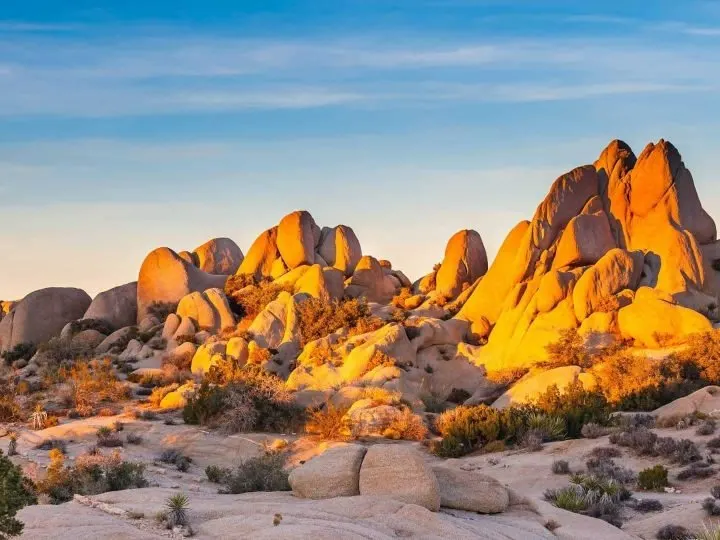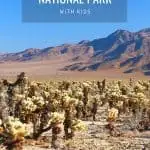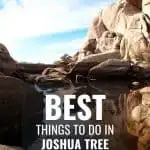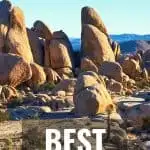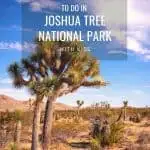With its towering boulders, diverse desert life, and iconic namesake trees, it’s no wonder that over two million people make the journey into the desert to visit Joshua Tree National Park every year. Thankfully, there are many great things to do in Joshua Tree National Park with kids, making it a great family destination.
Many people who visit Joshua Tree take a day trip from the Palm Springs or Los Angeles area. If they get an early start, visitors will find they can see and do quite a bit in a short amount of time. However, if you have more time, spending a couple days exploring this park is a great way to make the most out of your visit. Here are the best things to do in Joshua Tree National Park on family vacation whether you are on a day trip or overnight stay.
Things to do in Joshua Tree with Kids- Your Ultimate Guide to Visiting Joshua Tree National Park
Is Joshua Tree kid friendly?
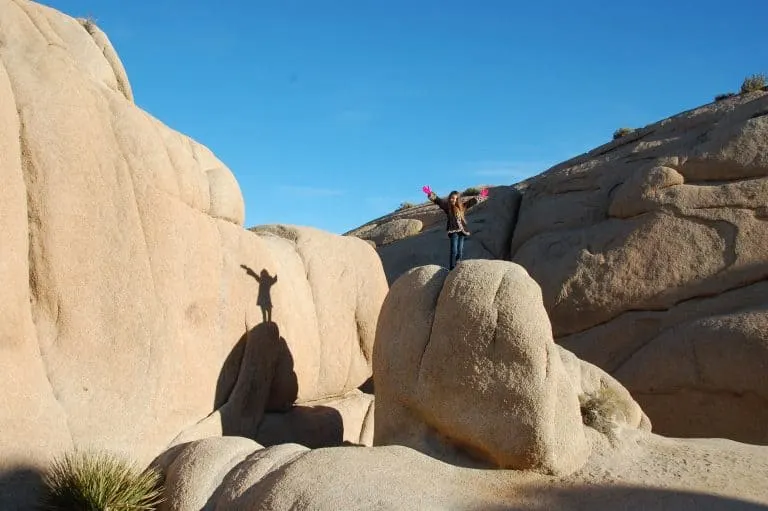
I would say Joshua Tree is exceptionally kids friendly! Why? Because all of the boulders make it like one giant playground for children. My kids and I can spend hours just climbing all over the huge piles of massive rocks, and each visit is a new experience thanks to the endless routes one can take.
Of course, this is nature and there are dangers to be mindful of in any wilderness situation. Keep kids close so you don’t lose them in the sea of boulders (speaking from experience). Be mindful of edges and never step on plants in order to access a route.
This is a desert environment so some plants are prickly, like the cholla cactus which will definitely prick you if you get too close. And while there are also snakes to be mindful of, they typically keep to themselves. They are most active in the spring and fall when they are more eager to sun themselves in the open.
When is the best time to visit Joshua Tree National Park?
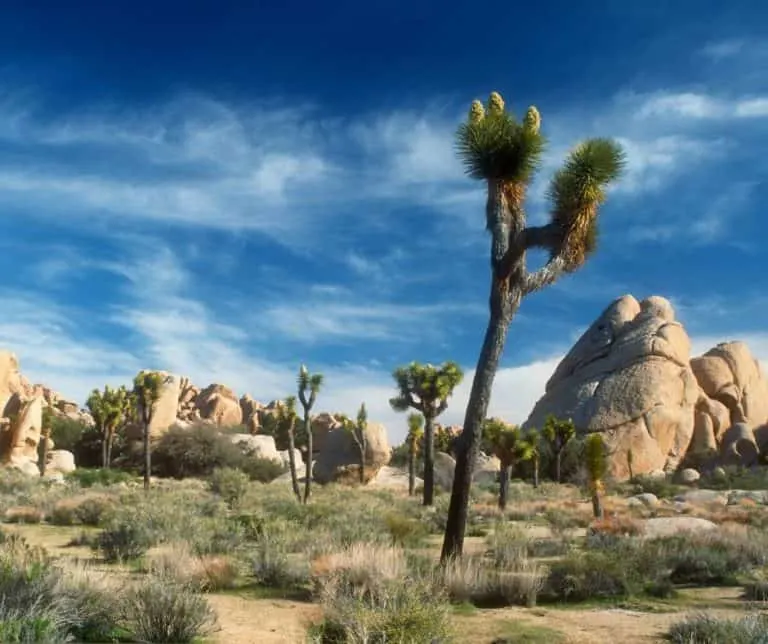
It is generally suggested that you avoid visiting Joshua Tree with kids during the summer months. The heat is oppressive, shade is minimal, and climbing on sun-baked rocks in the 100-degree heat could result in burns. From May to September, expect highs from 90-110.
Highs during the cool season (November through February) are typically in the 60s and 70s, perfect for hiking. March is still pleasant with temps in the 80s. April and October bring temps creeping into the 90s.
I have visited Joshua Tree multiple times in the winter and encountered highs in the 70s as well as the 30s. The reality is, the high desert is more prone to temperature swings so it is always a good idea to check forecasts before you pack for your trip. Evenings are usually much cooler (20-30 degrees) than the daytime highs, so pack accordingly.
My favorite time to visit Joshua Tree National Park is during a wildflower bloom after a wet winter when the desert comes alive with color. This typically happens around late March or early April. If you don’t get lucky with a wildflower bloom fear not- there is still plenty of amazing scenery to enjoy.
How many days do you need for Joshua Tree?
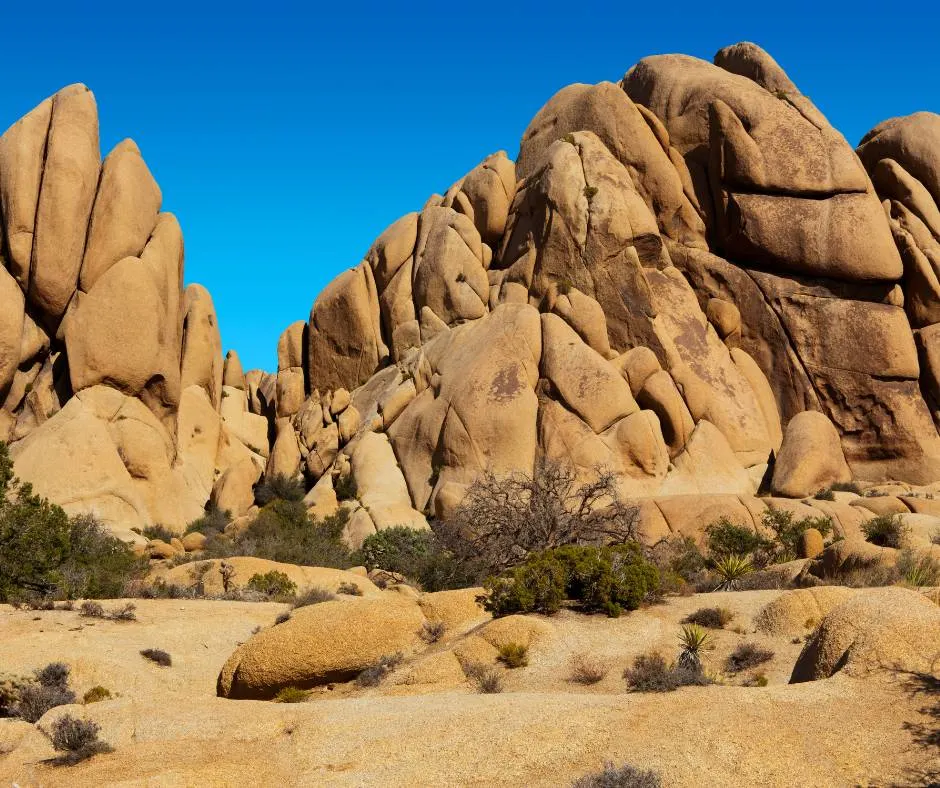
I think two full days inside the park is ideal for a visitor who wants to hit most of the park’s highlights. Still, you can actually see a good portion of the park’s main attractions with one full day of exploration.
Of course, more time allows you to take more hikes and explore more of the “lesser traveled” areas of the park and take longer hikes. It will also allow you to take the Keys Ranch Tour which we highlight below.
8 Important Things to Know Before You Go to Joshua Tree National Park
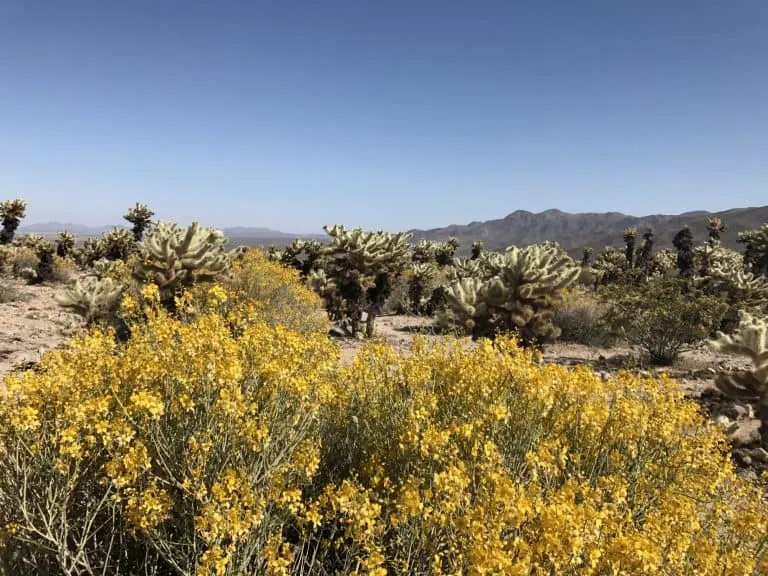
1. Joshua Tree is Home to Two Distinct Desert Environments
Joshua Tree National Park is home to two different deserts: the high desert, Mojave, and the low desert, Colorado. Each desert features different elevation, climate, plants, and animals.
Most of the big attractions you will want to visit in Joshua Tree with kids are in the high desert. This part of the park is typically cooler than the low desert (though still very hot during the summer months) and 40-degree temperature swings are common within a 24-hour period.
Bottom line: Bring layers.
2. Don’t Rely on Your Cell Phone
There is no cell reception in most of the park. You may receive cell service at the park entrance, up at Keys View, or high atop another mountain or boulder pile, but don’t count on it. I have found that newer phones will get satellite service to send messages but that’s about it.
Enjoy the downtime from technology and print out any maps you might want ahead of time. You can also ask for complimentary maps at the park entry points and visitor centers.
3. Bring Your Own Food
There are no food services within the park. My family brings a cooler full of sandwiches, drinks, and snacks when we visit the park. If you want to eat near the park, the city of Joshua Tree has several options within 30 minutes of the park entrance but you will only want to utilize these before or after your visit.
There are several places with picnic tables inside the park. Our favorite place to picnic is among the boulders at Hidden Valley.
4. Don’t Forget Lots of Water!
The only place to get water within the park is at a visitor center so bring MORE than you think you will need. The desert is often hot and humidity is very low. Carrying water with you is essential at all times.
5. Fill Up Your Tank
There are no gas stations inside the park. There are several along Highway 62 and Interstate 10. I suggest filling up before you enter the park so that you can fully explore without having to worry about fuel.
6. Camping Inside the Park, Lodging Outside
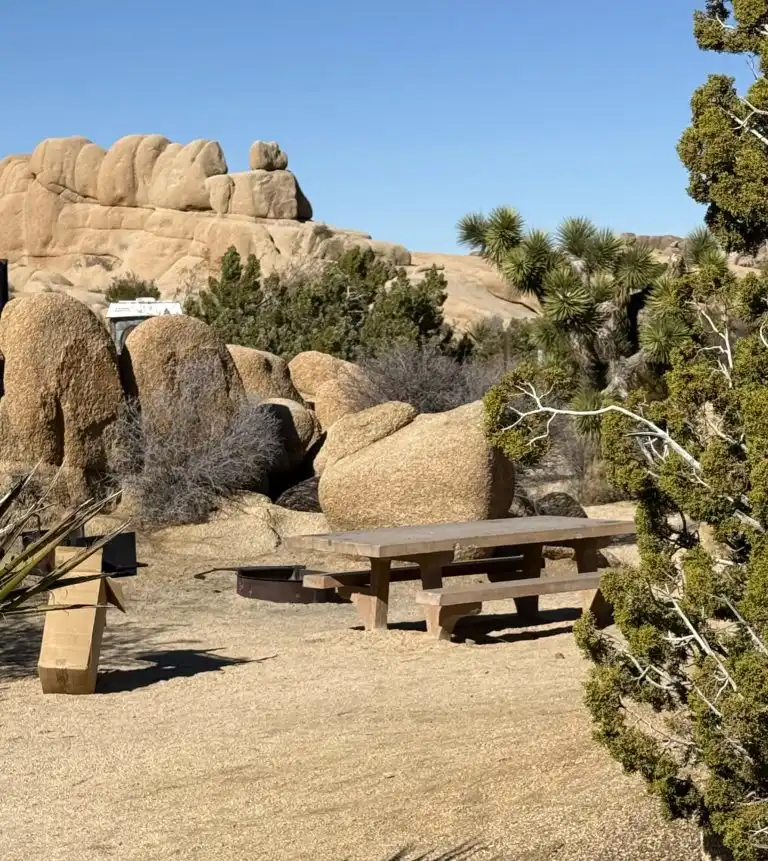
There are no accommodations inside Joshua Tree National Park. If you want to stay in the park you must camp. Jumbo Rocks Campground is my personal favorite.
There are several campsites at Jumbo Rocks which are quite secluded among the boulders and there is a nature trail you can take from the campground to various trailheads in the Skull Rock area. There are also tons of boulder piles to climb. There are bathrooms but no showers.
There is motel-style lodging nearby in Twentynine Palms, Joshua Tree, and Yucca Valley. Resort-style lodging can be found in Palm Springs which is about an hour away from the park entrance. There are also several great Joshua Tree cabins and vacation rentals.
Recently, we planned a last minute trip to Joshua Tree and could not find campground availability inside the park on a Saturday night. We were pleasantly surprised to find ample camping at Pioneer Town, an awesome Western filming site in the hills above Yucca Valley. Pioneer Town is a popular spot to visit to check out the historic buildings, browse cute shops, chow down at the location’s restaurant and bar, and listen to live music. There is even a little farm animal zoo and a vintage bowling alley!
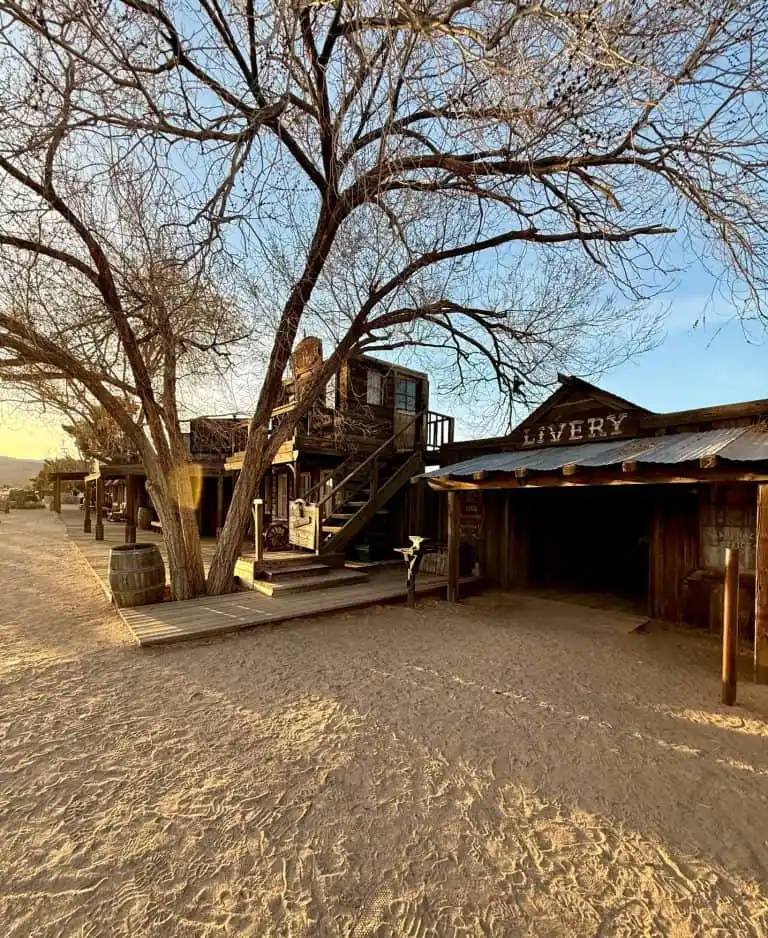
Trekaroo tip: It is easiest to book your camping stay at Pioneer Town on Hipcamp. You can check into the campground at the General Mercantile which is on the part of Mane Street that is closed to cars.
Are you staying in Palm Springs? Here are the Top 10 Things to do in Palm Springs with Kids.
7. Don’t Forget the Essentials
Remember- there are no services inside the park. Your Joshua Tree essentials pack should include sunscreen, a hat, plenty of water, food, and a first aid kit. You will want tweezers in your first aid kit in case someone in your party comes in contact with something spikey.
8. Start Early
Make the most of your time in Joshua Tree with kids by starting early. Lines at the park entrances, especially the Joshua Tree entrance, can get long if you arrive late morning to early afternoon.
Save time by buying your park pass online or at the park visitor center in Joshua Tree which is about 5 miles from the entrance station.
If you choose to use the 29 Palms entrance, start your morning by taking the scenic hike to 49 Palm Oasis which is on a spur road off Highway 62 in between the Joshua Tree and 29 Palms entrance.
This stunner of a hike (2.8 miles round trip) gains 620 feet in elevation through classic high desert scenery and has plenty of boulders for the kids to scramble on along the way.
The reward is the 49 Palm Oasis, a lush reprieve in the desert. A good portion of this trail is exposed so start early if you are visiting the park on a warm day.
Love the desert? Don’t miss our guide to Visiting Desert National Parks in California, Arizona, and Utah.
Which Joshua Tree National Park Entrance Should You Use?
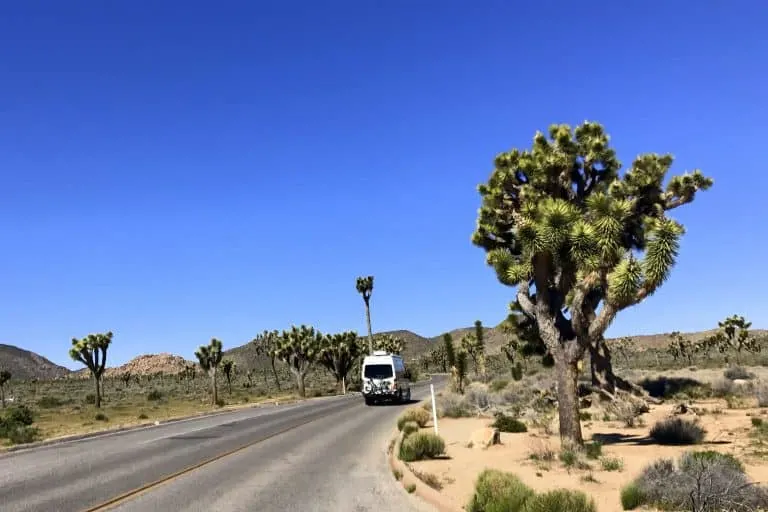
If you want to avoid lines I suggest entering the park at the north entrance in Twentynine Palms. The park headquarters are located here.
This is a great spot to fill up your reusable water bottles, peruse some exhibits, pick up your Junior Ranger booklets, and use the restroom before heading out into the park.
The Oasis of Mara is located next to the Oasis Visitor Center. There is a short, paved, nature trail (0.6 miles) which loops around the oasis and is nice for families with strollers.
If you arrive early in the day, take the Joshua Tree entrance. Otherwise avoid the West Entrance in Joshua Tree because almost all the people coming from Los Angeles and Palm Springs use the West Entrance and the lines for entry can back up for a mile during the busy season.
If you are coming from Arizona, you will want to use the southern entrance off Interstate 10. Your Joshua Tree experience will begin in the low desert on this route.
There are lots of great things to do in Palm Springs as well, so book a hotel and stay a couple days!
Explore more of the Golden State! Here are the best things to do in California with kids.
The Best Things to do in Joshua Tree with Kids in the High Desert
Home to diverse plants and wildlife, including the iconic Joshua Trees, the high desert is the most heavily visited part of the park.
For most families, the main attractions are the park’s boulders, which call visitors to climb and explore. Here are some of my favorite spots to visit in the high desert of Joshua Tree with kids.
Joshua Tree made our list of the Best National Parks in California. See what other special places made the list.
Skull Rock
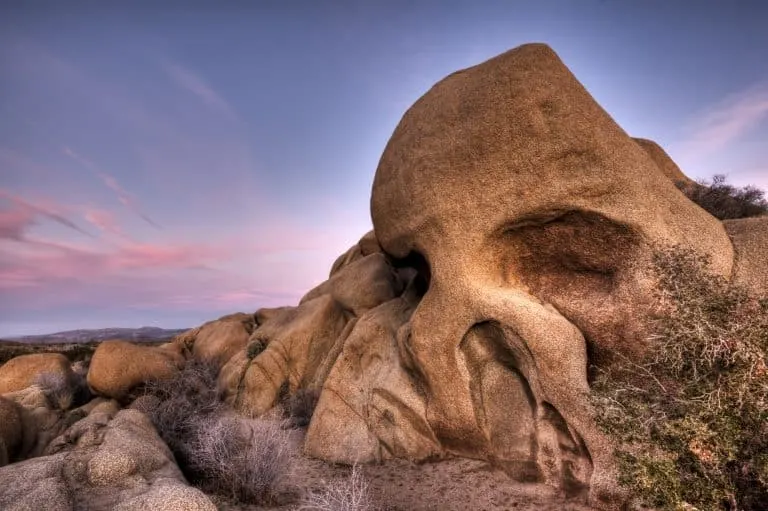
The massive boulder of Skull Rock really does look like a skull! Park alongside the road and enjoy scrambling and exploring the piles of boulders in this area.
There is a 1.7-mile loop trail from the Jumbo Rocks campground, but we prefer to skip the walk and just climb on the rocks and make our own trail through the boulders. Shoes with good treads are essential for safe climbing. Hiking or climbing shoes are much safer than tennis shoes.
Barker Dam Trail
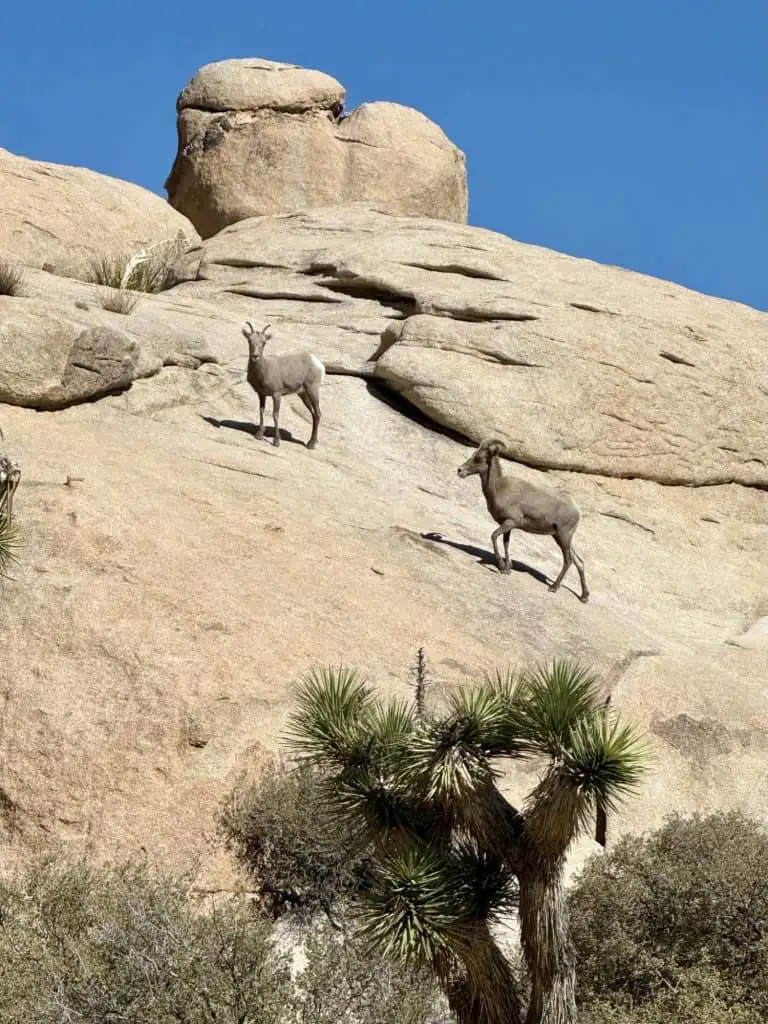
Kids will enjoy this 1.1-mile loop trail because there are plenty of boulders to climb atop along the way to the historic Barker Dam. Historically, bighorn sheep have used this dam as a watering hole but these days grasses seem to be choking out the area and the dam is not holding back any significant water.
Still, the dam is interesting to see and my family has spent hours climbing around in this area. On our most recent visit we were treated to watching a herd of bighorn sheep make their way up the boulders with little effort. Seeing them was definitely a trip highlight.
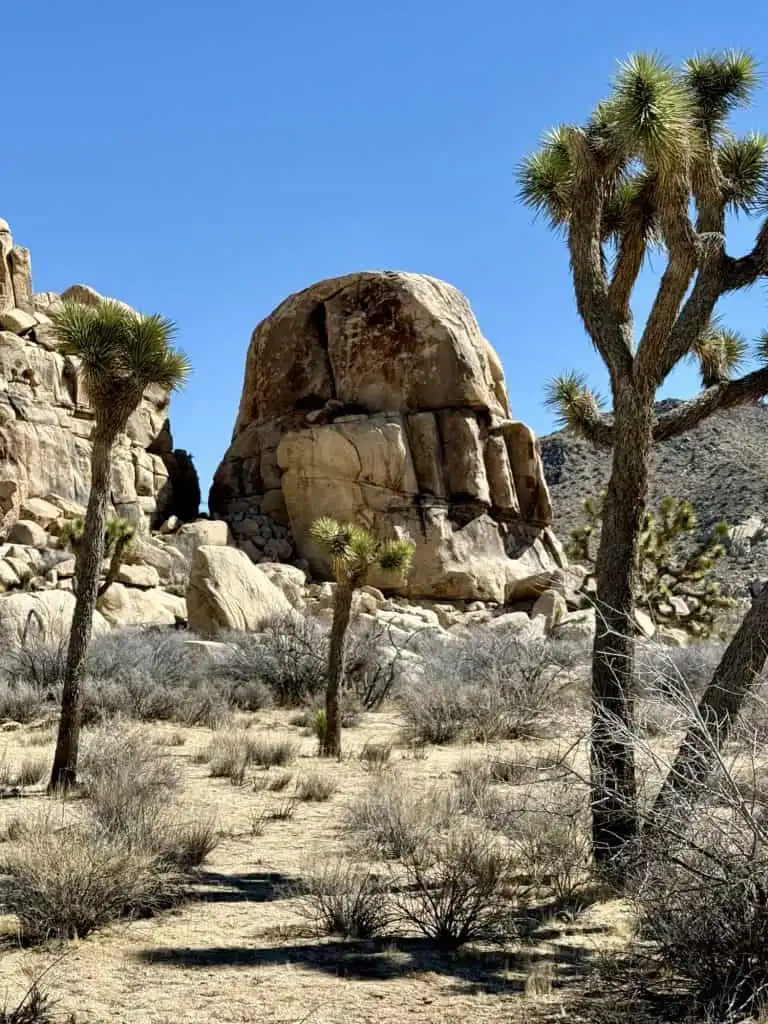
Trekaroo tip: There is Prehistoric rock art that can be found alongside the trail. Please respect the art by looking but not touching. This is a great place to teach kids about being stewards of the environment.
Maze Loop Trailhead Hikes
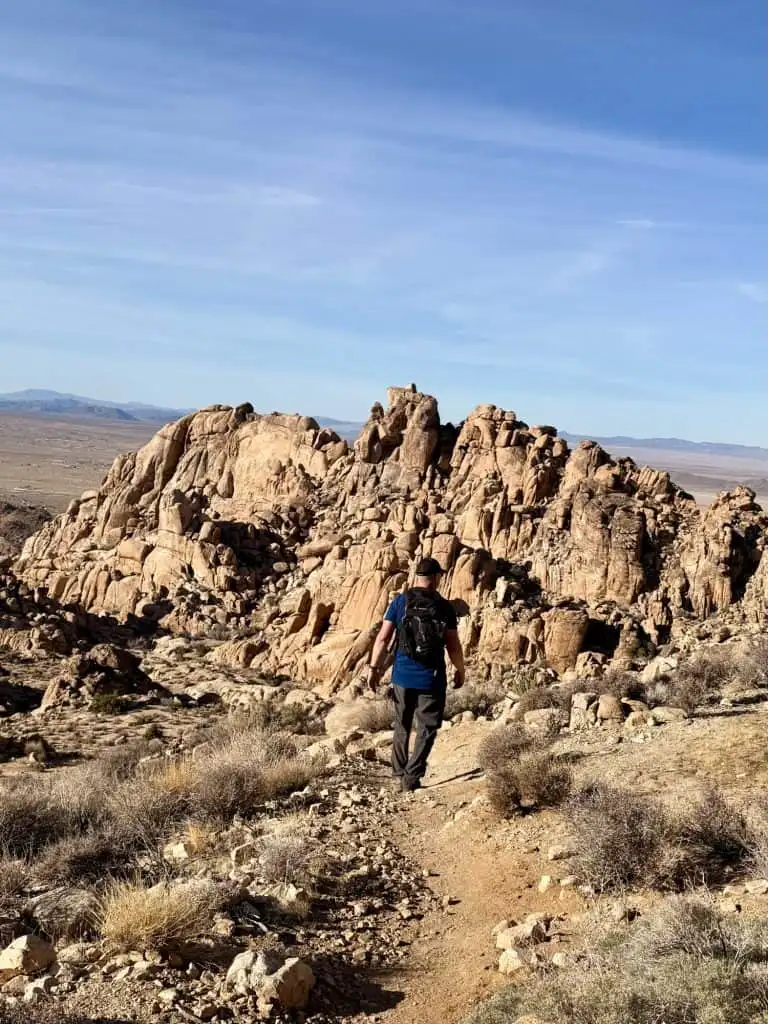
If you are looking for a longer trail that isn’t as strenuous as Ryan Mountain and is fas less crowded than many of the trails in the park, check out the trails in the Maze Loop Trailhead area near the Joshua Tree park entrance.
I recently came across these trails when I was looking for a “new to me” trail that was around five miles in length. While we started out planning to do the Maze Loop Trail (which is 5 miles in length and has an elevation gain of 400 feet), we decided to loop back to the parking area on the North View Trail to increase our hike length to 6.4 miles and our elevation gain to 718 feet.
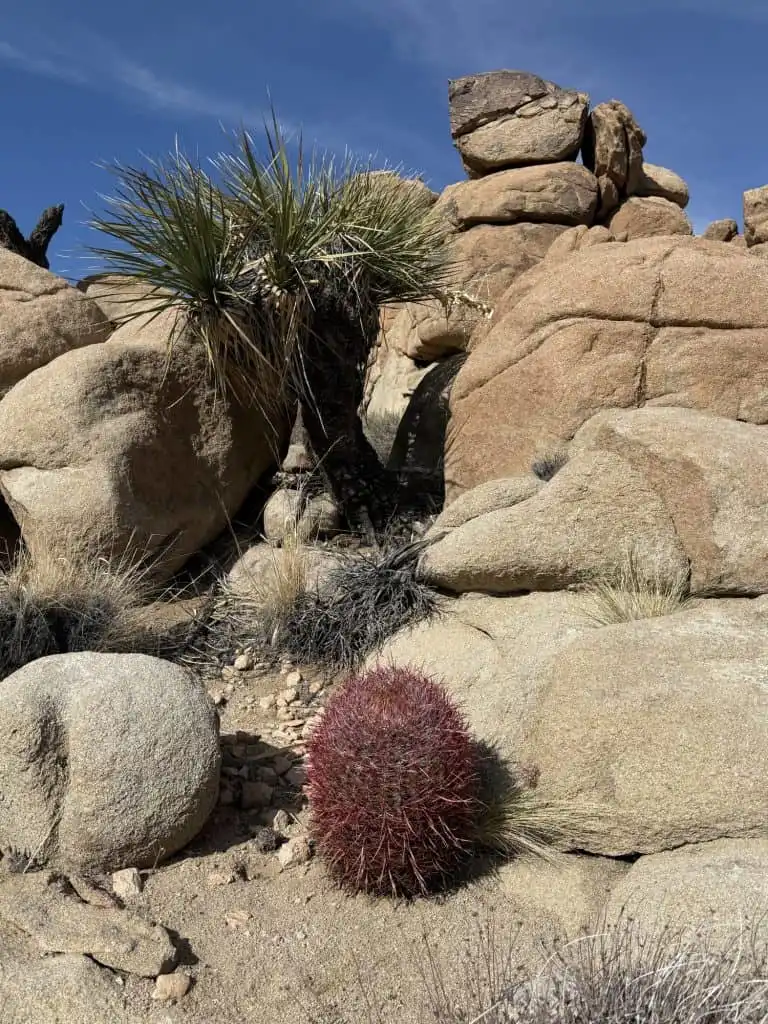
Both options have similar scenery which includes lots of boulders and geologic formations, as well as interesting plants. However, the North View does give you the bonus of checking out a nice view of the Joshua Tree/29 Palms townsites off in the distance. Even on a Sunday in prime season we saw very few people on this hike which was really nice.
Keys Ranch
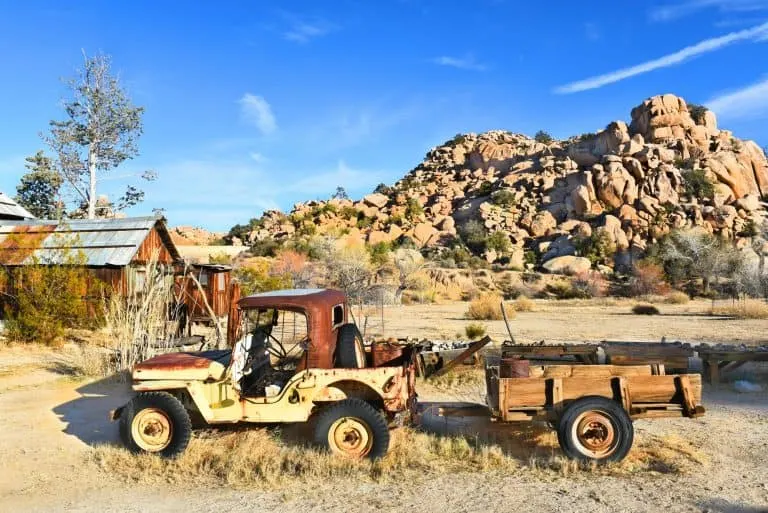
Long before Joshua Tree became a national park, hearty people called this part of the country home. The Keys Ranch Tour takes visitors to the former homestead of Bill and Frances Keys, which includes a ranch house, schoolhouse, and store.
This guided walking tour is a good way to learn about what life was like for Joshua Tree pioneers. It is 90 minutes in length and is limited to groups of 25 at a time. It often sells out.
You can only buy tickets at the Oasis Visitor Center in Twentynine Palms, beginning at 8:30am each day.
The cost is $10 for adults and children 12 and older, $5 for children 6 to 11, and free for 5 and under. Seniors pay just $5. Visit the park’s calendar page for tour times.
Hidden Valley
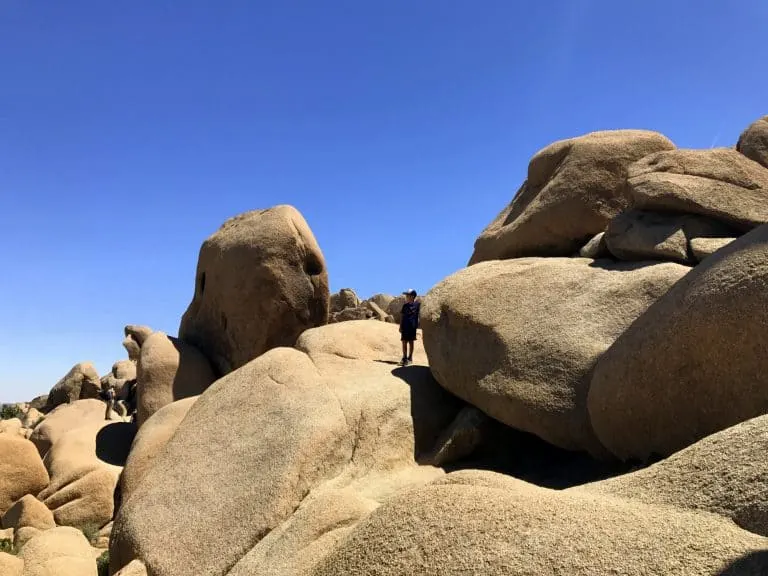
Hidden Valley is a great spot to climb and scramble over massive boulders. People love to scale these piles of rocks when they visit Joshua Tree National Park.
There is a nice 1-mile loop trail which circles around the Hidden Valley area. The area also features several picnic tables and bathrooms.
Ryan Mountain
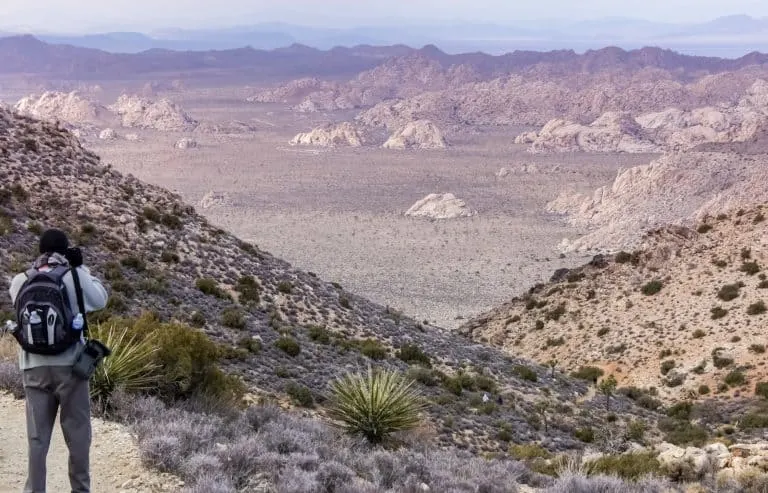
The Ryan Mountain trail is one of the most popular hikes in the park. The trail gains 1,000 feet in just 1.5 miles before reaching the 5,461′ summit. The reward for all that huffing and puffing is a 360-degree view of Joshua Tree National Park.
Keys View
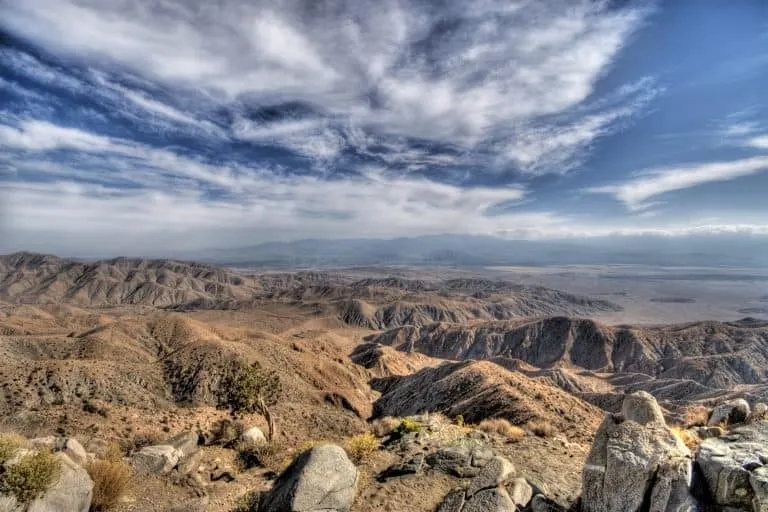
5,000 feet above sea level at the crest of the Little San Bernardino Mountains, Keys View is popular for, well, the views!
There is a short .25 trail which features a sweeping view of the Coachella Valley (home to Palm Springs and several other desert communities), Mt. San Jacinto, Mt. San Gorgonio, the Salton Sea, and the San Andreas Fault. On especially clear days you can even see the mountains of Mexico.
Arch Rock
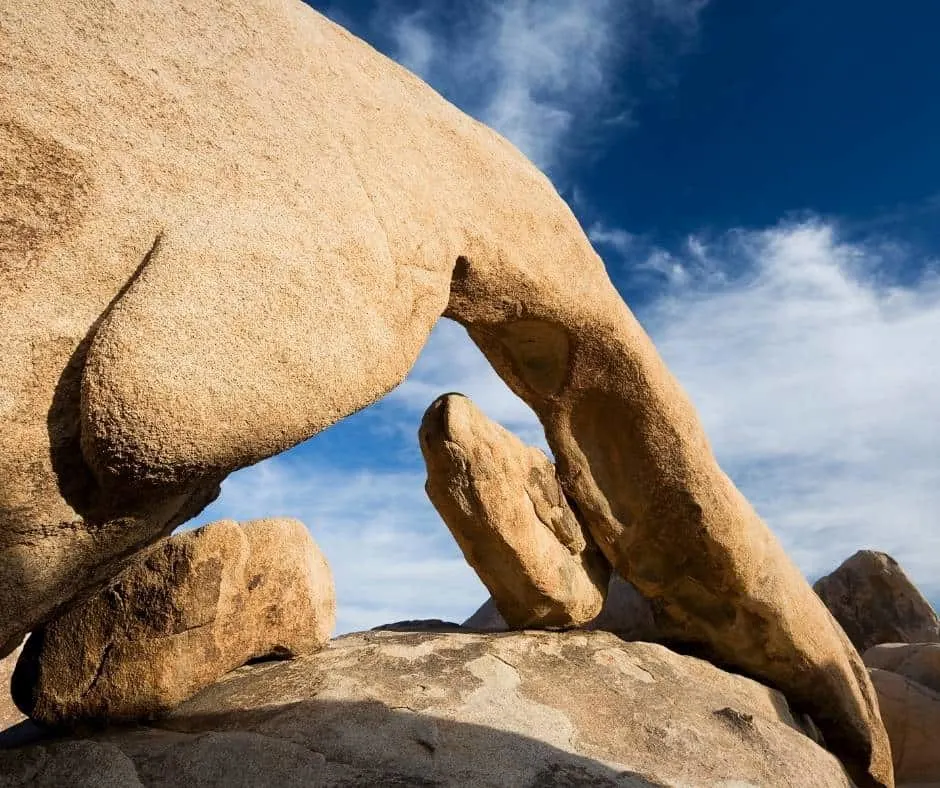
Before you make your way towards the low desert portion of the park make time to stop and take the trail to Arch Rock. The trail is an easy, 1.2-mile round trip hike. Heart Rock and Whale Rock are also in this area.
Fun fact: Unlike the arches formed by erosion that are common in Utah, this arch was created by lava pushed up through a fault line!
Enjoy the Gorgeous Night Sky
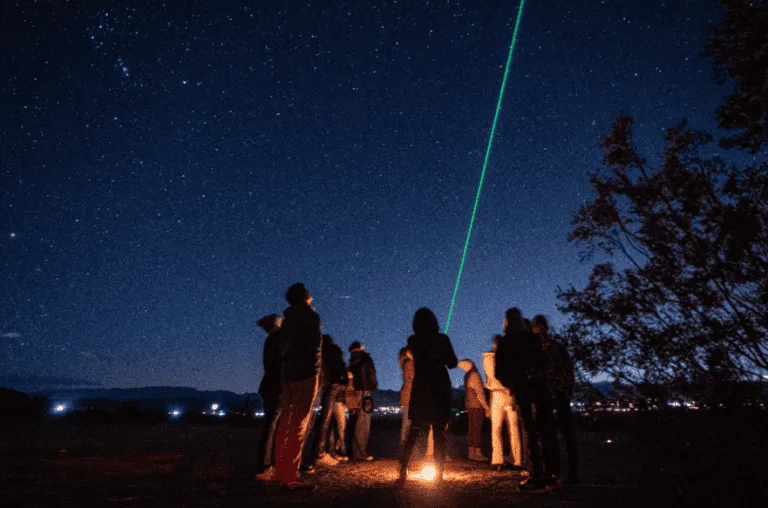
The night sky in Joshua Tree is filled with infinitely more stars than most of us are used to seeing at home. It is impressive to look up in the evening and take it all in, but what exactly are you looking at? Stargazing Joshua Tree specializes in creating exciting and educational experiences for families eager to learn more!
They have professional astronomers, state-of-the-art telescopes, zero-gravity pods and blankets to keep you cozy while you gaze up at the sky, binoculars, and even deep space photography to help you capture your memorable evening and share with others. Their two-hour experiences will have you appreciating the beauty of the universe even more than before.
Things to do in Joshua Tree National Park’s Low Desert
The low desert portion of the park is not as heavily visited, but certainly deserves your attention. Those staying in the Coachella Valley can take Pinto Basin Road through the low desert until it meets up with Interstate 10, east of Indio.
Interstate 10 West will take you back to the Coachella Valley. If you are staying in one of the high desert communities or heading back to the Los Angeles area, consider at least driving down to the Cholla Cactus Garden and Ocotillo Patch.
Cholla Cactus Garden
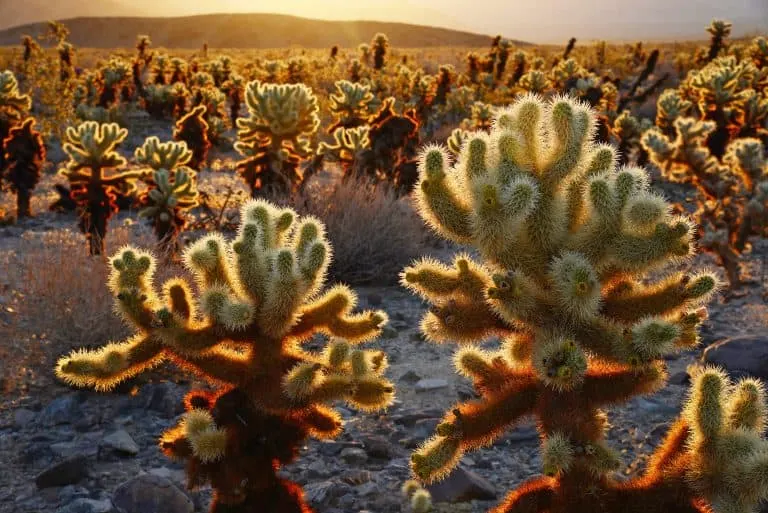
Located near where the high desert and low desert converge, the Cholla Cactus Garden is filled with plants that look soft enough to cuddle. Resist your urges!
The Cholla cactus may have the nickname “Teddy Bear Cactus” but it is far from cuddly. The plants’ needles will attach to anything that touches them using curved barbs on their tips.
A short, .25-mile trail meanders through a large patch of these pesky cacti. It’s fun to take pictures pretending to touch or snuggle with the plants, just don’t get too close!
Ocotillo Patch
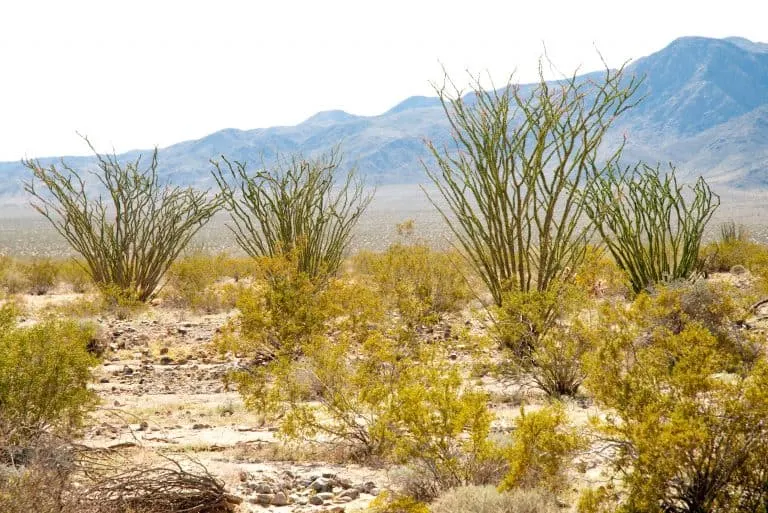
Just beyond the Cholla Cactus Garden is the Ocotillo Patch, a collection of these majestic desert plants. They are especially beautiful in the spring when they are ablaze with red-orange blossoms.
Cottonwood Visitor Center
This small visitor center is a good place to stop for maps, to talk with rangers, or to turn in completed Junior Ranger Booklets.
Bathrooms are available. Take the short walk to Cottonwood Spring, a popular birding spot that features a fan palm oasis and cottonwood trees.
Find National Parks near you! Trekaroo has dozens of guides and reviews of our nation’s national parks.
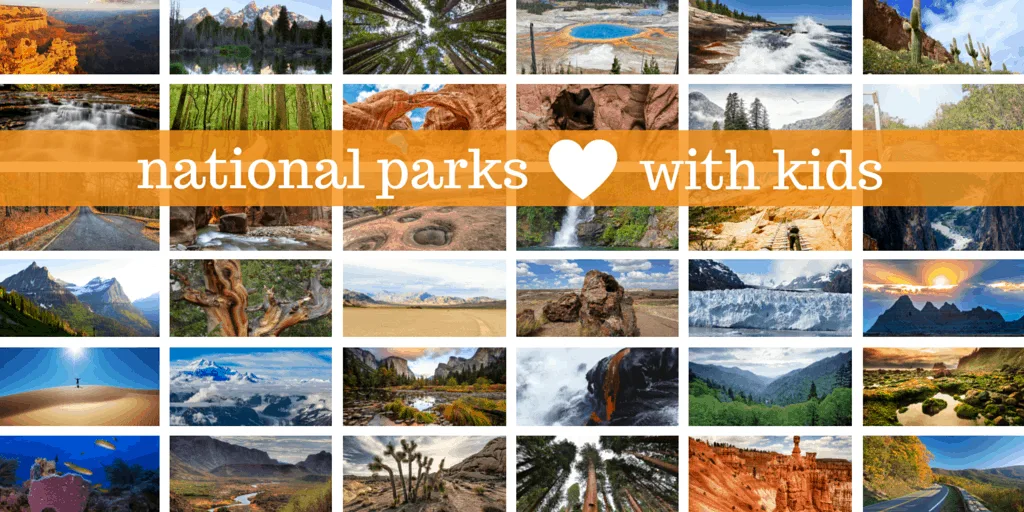
- 83 Best Disneyland Tips & Tricks for 2025 - June 20, 2025
- The 15 Best Island Vacations for Families in 2025 - June 10, 2025
- 10 of the BEST Waterfalls in the US- Easy Hikes and Big Views - June 9, 2025

